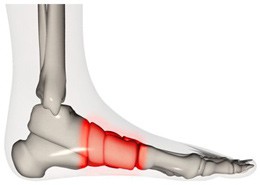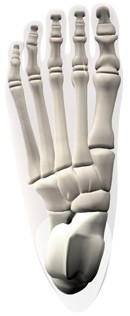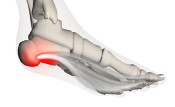THE CAUSE
The HEEL PAIN is a rather common problem that humans have to deal with. It can be really unpleasant, but fortunately there’s no serious illness behind the pain in most cases. The pain is usually caused by mechanical problems, however there can be arthritis, infections, autoimmune and neurological problems, trauma, osteoporosis and various bone related diseases or diseases involving multiple organs. Most heel pains are caused by the illness of the thick connective tissue ligaments that overarch the sole, called plantar fasciitis. This structural disorder is due to the ligaments’ important role in the maintenance of the foot’s muscles, tendons and arches. The most characteristic symptom of this disease is that the pain occurs in the morning when you put your weight on your feet, however later on the pain moderates or disappears and it returns in cases of long standings or while climbing stairs. This kind of pain is especially common amongst teenagers because at this age, the heel bone is not fully developed and can easily rub against other bones. Undeveloped and too flat-soled slippers, flip-flops and/or wearing high heels can also contribute to this problem.
SOLUTION
Usually the heel pain goes away by itself, but there are cases which should be checked by a specialist. Some insoles heel cushions relieve the tension of the plantar fascia thereby reducing the pain. The issue can be reduced with the usage of properly chosen shoes (shoes that don’t have completely flat or too high heels) and/or personalized insoles.


THE CAUSE
The neonatal FLAT FEET – the lack of longitudinal arch – is normal in infancy because the arch of the feet develops later with the growth of the muscle tone. The thickness of fat under the skin enhances the semblance of flat feet. In the majority of cases, the problem disappears by itself, so the lack of development of the arch before the age of 2 is not considered abnormal. Forced standing or walking can cause overload, which can result in the continuation of the deformity.
SOLUTION
The pubertal and adult flat foot can be corrected very well with proper, fitted insoles. The computer designed, individually applied insoles can be extremely effective. Aside from the insoles, you should also regularly perform leg/foot exercises as well. Amongst sportsmen, especially athletes and runners, it is very important to use proper shoes because a poorly developed shoe can cause significant alternations to the feet. Orthopaedic surgery should only be considered if the ligaments and bones of the feet are fixed, and even whilst wearing flat foot correcting insoles, the condition keeps causing continuous complaints.

Healthy longitudinal arch

Lack of longitudinal arch – Flat foot
THE CAUSE
We can talk about this issue when – usually the second or third – metatarsals sink. The descending of the bones causes more pressure against the ground, which causes plantar pain whilst walking. Calluses under the bone are a typical outcome of this problem which recurs despite pedicure treatments. These calluses are often accompanied by big toe bunion deformity or little finger hammer toes. The METATARSAL SINKING can be the result of several different factors such as long term overload of feet, wearing high heels regularly, or inherited genetic predisposition.
SOLUTION
In order to prevent your feet from metatarsal sinking, you should wear comfortable, not too thin-soled shoes with maximum 3-4 cm high heels. Also, it is important that the nose of the shoe not be too tight because it can cause discomfort, pain and it contributes in the development of disorders, or it can worsen the current state of the feet. You can slow down or even stop the disorder by using special, metatarsal lifting insoles, or orthopaedic shoes. You can achieve the best results by using custom insoles made personally for you; the supports and lifts have to be in the right place.

Healthy Metatarsal

Metatarsal sinking
THE CAUSE
The essence of HAMMER TOES or digitus malleus is that the bending and stretching muscles’ balance collapses of the phalanges, due to this, the proximal phalange rises, while the medial phalange sinks resulting in the hammer shape. Most commonly the alternations develop in the second and third finger, sometimes even on both feet simultaneously. Its development is most often due to bad-fitting shoes, such as very high heels and narrow-toed shoes, which hold the toes in bad positions. Nine out of ten people, who have this disorder are females. Another factor may be the foot transverse – or longitude arch sinking – as well as other changes of organ system diseases, such as diabetes.
SOLUTION
Physiotherapy treatment can improve the movements of the toes’ joints, thus solving the muscle tension, as well as to restore the proper direction drawing. In addition, it is very important to wear not too high heels, thus allowing your toes to have enough space. Symptoms can be greatly reduced by using custom insoles which have the right support for your feet.

Healthy foot

Hammer toes
THE CAUSE
Normally, the foot is the widest in the tarsometatarsal joint area, and the big toes point straight ahead. The BUNION develops due to the sinking of the transverse arch, so the shortened tendons pull the big toe towards the smaller ones. The main cause of bunions is wearing too tight and high heeled shoes, therefore this problem is most common amongst females, but in other cases, hereditary factors can cause this joint damage. Usually, the sinking of the transverse and/or longitudinal arch is an accompanying symptom.
SOLUTION
The most important is the proper shoe selection, which provides enough space for the toes, if you’re wearing tight shoes, then the continuous pressure on the toes may cause arthritis. It is recommended to perform regular leg exercises, which may also be beneficial to slow down the pace of the disease, but it is important to know that complete correction of the bunion deformity cannot be accomplished by only exercises. Only surgery can restore the shape of the foot, but this does not always produce the expected results. After surgery, the foot deformity may come back, and walking can become difficult. If you just remove the bony outgrowth, the bunion can develop again. It is important to have emphasis on prevention; you should use well-fitted shoes and custom insoles.

Healthy foot

Bunion

Twisted
shoulders
Twisted
spine
and hips
Introverted
knee
Extroverted
ankle

Without custom insoles
With custom insoles
The static of your foot
Your foot bears the weight of the entire body as well as performing complex movements for walking, running and dancing. Faulty bio mechanics of the feet can lead to pain and injury in the ankles, shins, knees, hips and low back as well as the feet. Your body could be balanced with the rightly chosen customized insoles and shoes which may help to prevent the long-term or irreversible deformations and pains.
 Magyar
Magyar  Deutsch
Deutsch 







